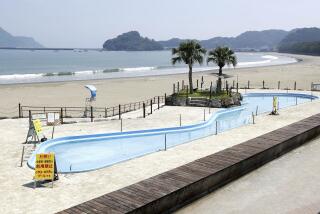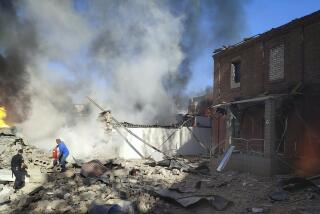A look at Japan’s damaged nuclear plants
- Share via
The situation at one of Japan’s crippled nuclear power plants seemed to go from bad to worse as an explosion Saturday destroyed a building that houses one reactor and on Sunday another reactor began experiencing problems with its cooling system. An estimated 170,000 people who live within a 12-mile radius of the plant have been evacuated as a precaution in case the worst-case scenario occurs — a meltdown followed by the release of radioactive ash. An estimated 30,000 people have been evacuated within a six-mile radius of a nearby plant.
Here’s a look at where things stand.
What caused the explosion?
A buildup of hydrogen in the disabled cooling system of one of the reactors at the Fukushima No. 1 (Daiichi) plant about 150 miles north of Tokyo. The explosion damaged the building the houses the reactor and its cooling system. However, the reactor containment vessel, which houses the radioactive fuel rods, remained intact, officials told the International Atomic Energy Agency, the U.N.’s nuclear monitor.
Photos: Scenes of destruction after the earthquake
Was there a meltdown?
Not according to Ichiro Fujisaki, Japan’s ambassador to the United States, who spoke on CNN. But other officials said two of the reactors at the plant may have experienced meltdowns. Engineers have not been able to get close enough to the plant to rule that out, said Toshihiro Bannai of Japan’s Nuclear and Industrial Safety Agency.
“We see the possibility of a meltdown,” he said on CNN.
How serious is it?
The explosion itself does not appear to have caused radiation to leak into the environment. But experts said the problems stemming from Friday’s magnitude 8.9 earthquake and the resulting tsunami rank as the third most severe nuclear accident in recent history, following the 1986 Chernobyl disaster and the 1979 accident at Three Mile Island.
Water from the tsunami disabled diesel generators supplying power to emergency cooling systems for five reactors at the Fukushima No. 1 plant and a nearby plant known as Fukushima No. 2 (Daini). Without power from the generators, the cooling system pumps cannot circulate cool water around the radioactive fuel rods. As a consequence, the water will boil off and the fuel rods will overheat and melt, which could lead to a massive escape of radiation. Already, some radiation has apparently escaped from one reactor at the No. 1 plant, as well as some hydrogen, which was the source of the explosion.
Authorities said the cooling system at a sixth reactor, located at Fukushima No. 1, broke down Sunday morning.
Why were people evacuated?
Officials ordered the evacuation to protect civilians in the event that radiation leaked from the plants.
“You want to err on the side of being cautious,” Chesser.
But the decision to evacuate is not one that officials take lightly, since putting so many people on the roads at once might raise the risk for traffic accidents, said Peter Bradford, former commissioner of the U.S. Nuclear Regulatory Commission.
Have civilians been exposed to radiation?
Yes, though not many, officials say. Japanese officials have scanned thousands of evacuees for radiation exposure, and at least nine of them have tested positive, although they do not appear to have any immediate health problems. Japan’s Nuclear and Industrial Safety Agency estimated that as many as 160 people may have been exposed.
The threat to civilians was diminished by the evacuation, and the fact that the prevailing winds at the site generally blow out to sea. They have been dispersing the small amount of radiation that has already been released.
What about the safety of the workers at the plant?
The risk is certainly greater for them, said radiation biologist Jackie Williams of the Center for Biophysical Assessment and Risk Management Following Irradiation at the University of Rochester Medical Center. All the immediate casualties at Chernobyl were among workers at the site who were exposed to heavy doses of radiation.
So far, however, there is no evidence that has happened at Fukushima. Four workers at the plant were hospitalized for injuries suffered in the explosion, but not for radiation burns. Random tests on three other reactor workers showed they had received some exposure, but Tokyo Electric Power did not release any data on the extent of exposure.
Medical physicist Jerrold Bushberg of UC Davis has received reports that radiation exposure in the site was 1,000 microsieverts per hour. “That’s a high level, but not extraordinarily high,” he said. “Even if someone had to work in that environment for 48 hours, that is below what radiation workers would be allowed in a year.”
How does the possible exposure compare with what happened at Three Mile Island and Chernobyl?
The average radiation dose to evacuees from the most highly contaminated areas involved in the Chernobyl disaster was 33,000 microsieverts, according to the IAEA. Among the 600,000 people most affected, there were an estimated 4,000 additional fatal cancers on top of the 100,000 fatal cancers expected in that population.
The average dose of radiation absorbed by people who lived within 10 miles of Three Mile Island at the time of the 1979 accident was 80 microsieverts, according to the American Nuclear Society. For the sake of comparison, the exposure from a single X-ray is 100 microsieverts.
Has the threat of a meltdown or further explosions passed?
Most experts believe the chances of such a disaster are remote. But some observers said Japanese officials have not provided enough details to allay their fears.
“We’re very, very concerned about the lack of information coming out of the government, “ said Aileen Mioko Smith with Green Action in Kyoto, Japan. She said there was already vocal opposition in Japan about building new power plants. “I think there will be large public implications from this.”
Could radiation make its way to the United States?
A catastrophic meltdown in Japan would probably not threaten the health of Americans living in Hawaii or on the West Coast, experts said.
“There would be no cause for any concern,” Bushberg said. Any radiation that escaped from the plant would be diluted by air currents as it traveled over the Pacific Ocean. Should a meltdown occur, the U.S. Departments of Energy and Defense would surely track the movement of any radiation plume, Alvarez said.
What measures were taken after the explosion ?
Officials of Tokyo Electric Power Co., which owns the plants, began pumping seawater into the disabled reactor to keep it cool. The company reported to the IAEA that this action had reduced the release of radiation. Some experts called that an act of desperation that seemed likely to fail.
“I would describe this measure as a Hail Mary pass,” said Robert Alvarez, an energy expert at the Institute for Policy Studies. Alvarez spoke at news conference Saturday organized by the environmental group Friends of the Earth.
Others, however, said the reduced levels of radiation at the site indicate the plan is working. “I’ve been encouraged by what I’ve been hearing,” said Ron Chesser, director of the Center for Environmental Radiation Studies at Texas Tech University.
Why didn’t they pump in seawater before?
The salty water is very corrosive and can damage the pipes in the cooling system, so it has never been used for cooling a nuclear core, experts said. But when the explosion destroyed the system for circulating freshwater through the core, company officials thought they had little choice left but to inject cold seawater into the containment vessel as a last-ditch measure to cool it. At this point, damage to the pipes is inconsequential.
Photos: Scenes from the earthquake
Time staff writer Amina Khan contributed to this report.
More to Read
Sign up for Essential California
The most important California stories and recommendations in your inbox every morning.
You may occasionally receive promotional content from the Los Angeles Times.













